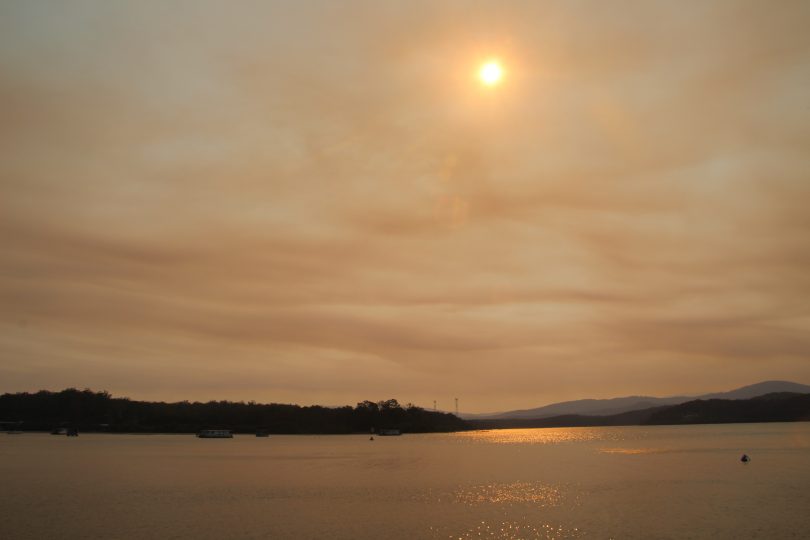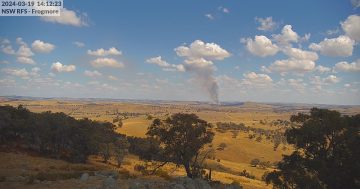
Braidwood’s Mount Gillamatong was barely visible on Thursday afternoon. Photo: Mary Mathais.
Today’s smokey skies are the worst the region has seen so far with Southern NSW and the ACT choked while firefighters on the ground and in the air work to control fires near Braidwood and Cooma.
Southern NSW Local Health District (SNSWLHD) is urging people with respiratory conditions to take extra care, with concerns poor air quality may affect their breathing.
“People are advised to take precautions and stay indoors to avoid irritations to the eyes, nose and throat, and to avoid aggravating existing lung and heart conditions,” a Health spokesperson says.
“Older adults and people with heart and lung conditions are most susceptible to the effects of air pollution and excessive smoke.”
SNSWLHD has outlined a range of simple tips to help stay safe and healthy during the smokey air quality:
- People with asthma, heart disease and other lung and heart conditions should avoid vigorous outdoor physical activity when smoke is around.
- Staying indoors with the doors and windows shut is an effective way of reducing exposure to smoke.
- People with asthma or a lung condition should follow their Asthma or Chronic Obstructive Pulmonary Disease (COPD) Action Plan and carry their relieving medication with them. If your symptoms do not settle, seek medical advice.
- In case of emergency always dial Triple Zero.
If smoky conditions are prolonged for several days or more:
- Keep doors and windows of your home closed while smoke is about and take advantage of any breaks in the smoky conditions to air out your home.
- If possible, spend some time in air-conditioning with the air-conditioner set to recirculate indoor air.
- Consider postponing outdoor events, especially sporting and other physically active events.
- Avoid indoor sources of air pollution like candles, incense, and wood burning heaters.
For more advice visit the NSW Health website.
The increased smoke has prompted some residents to ring alarm bells. Emergency services are urged people to only use the emergency triple-zero number if they see an unattended fire. The appeal comes after the ACT Emergency Services Agency received more than 250 triple-zero calls about the smoke.

The two fire fronts are burning in widespread areas near Braidwood. Photo: Supplied.
Meantime, an out of control fire continues (1:30 pm November 29) to burn across a rugged area of 1150 hectares west of Braidwood and at Cooma near Solomon Lane.
Both are currently listed at the ADVICE alert level. For the latest check the NSW RFS website.
Easterly winds are pushing the smoke haze around Southern NSW and the ACT, adding to the load delivered earlier in the week from Victoria and Northern NSW.
Time Lapse of the Tallaganda fire.This footage was taken Wednesday 27 November, 6pm – 8.30pm from Hoskinstown.
Posted by Lachlan O'Neill on Wednesday, November 27, 2019
The Braidwood bush fire, known as the North Black Range Fire is the one of most concern at this stage.
The RFS report that the fire is burning in the Tallaganda National Park in the vicinity of the Forbes Creek, North Black Range Fire Trail, Ralpine Valley, and Mount Palerang.
There is a second fire also burning within the National Park called the Mt Palerang Fire. These two fires are likely to join over the coming 48 hours.
The fires have been spreading in all directions with significant spotting westwards towards Forbes Creek and eastwards into the Ralpine Valley.
Under forecast Severe Fire Danger today (November 30), the fire is likely to be difficult to control and may run with spotting, embers and direct attack into Bombay, Little Bombay and Bendoura.
RFS Advice:
- Residents and landowners around the Bendoura, Little Bombay and Bombay areas need to be prepared for the fire to impact late on Friday. If you are going to stay and defend your home you must be well prepared.
- Residents and landowners around the Forbes Creek and Hoskinstown area need to remain vigilant. Erratic weather and gusty winds will make the fire unpredictable.
- Embers can cause spot fires well ahead of the main fire. Only stay and defend your property if you are well prepared.
- If your home or property has been impacted by fire, ensure you check for any remaining hot spots and embers.
Monitor conditions and take advice from firefighters in the area. Know what you will do if the fire threatens.
Firefighters and aircraft are working to slow the spread and notify residents in the area.
Residents can monitor fires in NSW and the ACT via the NSW Fires Near Me page on the NSW Rural Fire website.
A total fire ban remains in place across the ACT, Snowy Monaro and Southern Ranges region.

The view west from the Clyde River near Batemans Bay. Photo: Alex Rea
Original Article published by Michael Weaver on the RiotACT.










